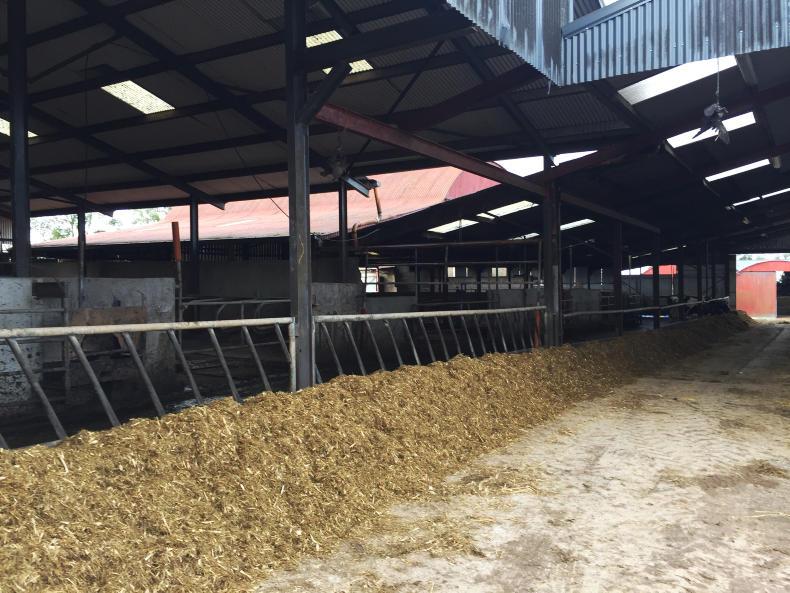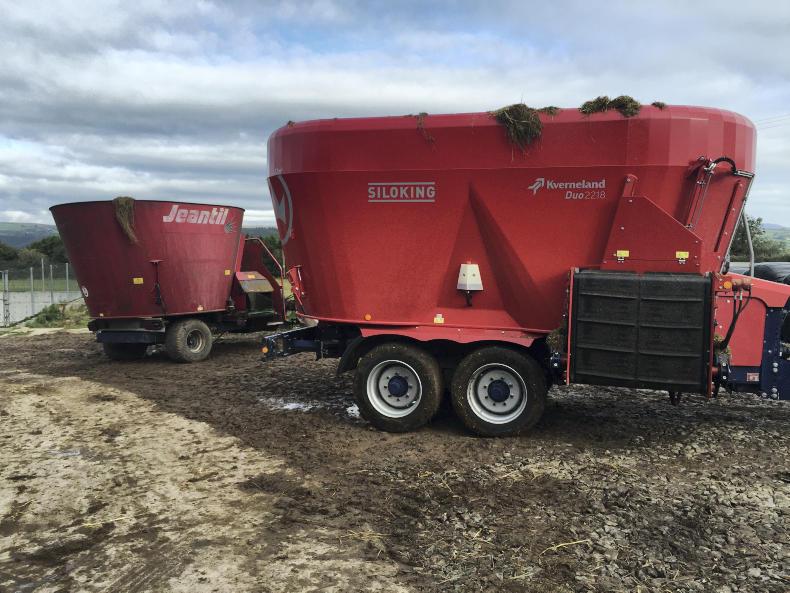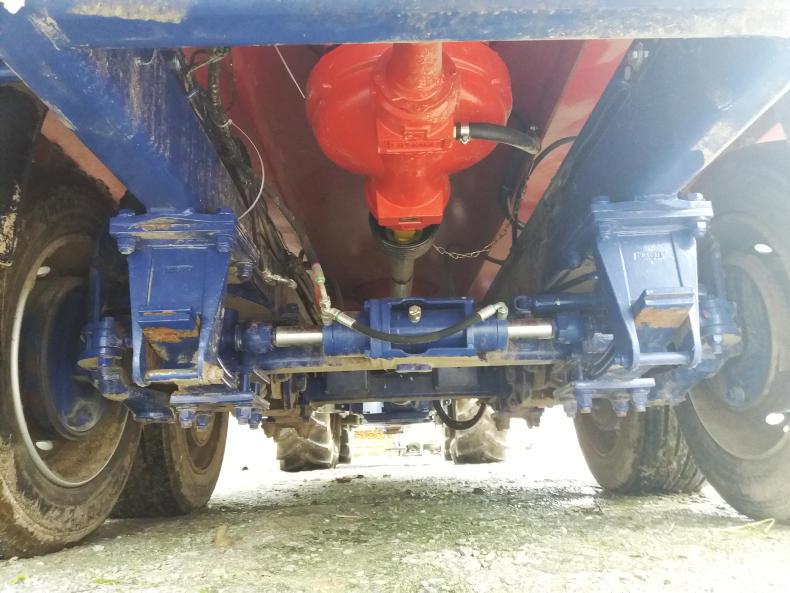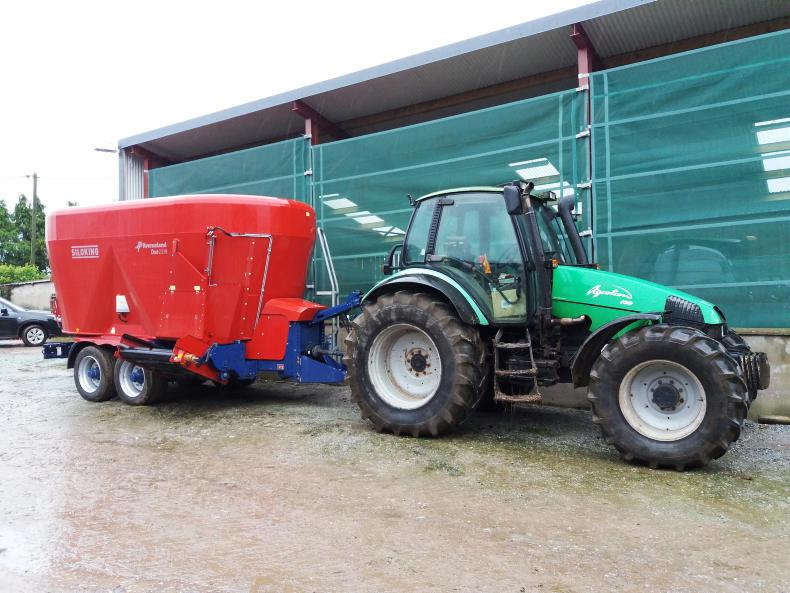Michael, Patrick, David, Patsy and Pat Ahern are cousins who farm within a mile of each other and all milk cows.
This time last year, three of the five farmers were feeding cows with three diet feeders. Pat wasn’t diet-feeding then but has since started as he realised the benefits of it.
The cousins decided to pool their resources and invest in one diet feeder to help feed all of their herds.
Group thinking
Patrick was in favour of the change they made. “Machinery wears out and the diet feeders we were using were getting old. The biggest reason for the change was labour and costs. You’d get a lot of work done while someone was feeding your cows. You knew your stock were fed whether you’d to go to the mart or you had a cow stuck in a cubicle or whatever.
The machine is charged out to each member on an hourly basis
‘‘When the cows were starting to calve, we could spend time with the calves and, most importantly of all, the dairy cows and dry cows got the correct diet. All too often, the dry cow is neglected and we look after the milking cow.”
So, how do five cousins set up the purchasing, payment and operating of a diet feeder to work in seven different yards?
“We set up a company which operated like a machinery ring to carry on what our fathers did before us. It was different in their day where one man had one machine and the other man had something else. This is following the same principle but is more structured and organised. The machinery company, which we are all members of, owns the machine.
A loader in every yard owned by the individual members fills the feeder and the tractor used was hired. Patrick’s son was hired as the driver.
According to Pat, who is milking 80 cows, it cost him €29/day in machinery costs last year. This is based on the number of hours the machine spent in his yard, which is quite important.
“The machine is charged out to each member on an hourly basis. The longer a machine spends in a yard, the more the man is charged.
"It’s in every member’s interest not to delay the machine as he will be charged more. Blocks of silage are fully cut or bales of silage are unwrapped to minimise delay. It also speeds up the loop of farms the feeder has to call to which can take up to seven hours a day.

"All costs including depreciation, tractor hire, etc, are split on a per-hour basis among the five members.
“Last year, we hired a man and tractor separately but this year we are hiring the man and tractor complete from a contractor. This is simpler and we don’t have the hassle of finding a skilled operator to drive a wide selection of loaders in different yards and operate a large valuable diet feeder. When we stop using the diet feeder, the tractor and man return to their other work.”
I asked the five members why they chose a Siloking Kverneland Duo 2218. “We got a demo of the machine and it seemed very well built. It has only completed one year, but so far, so good. There’s plenty of metal in it which should last a few years and it won’t cost a fortune to replace it if we split the purchase costs among us again,’’ Patrick said.

Speaking to Michael, who initially came up with the idea over a year ago, he is very happy with the changes they have made.
“All of us have more time for the cows and we don’t need an extra man in every yard to drive a diet feeder. It has saved a lot of time, money and, most importantly of all, the cows are doing better as every day the feeding is done right. Dry cows are getting the correct diet and not being left as an afterthought in the very busy times in the spring.”
Expansion
I asked the group if there were any plans to expand the machinery ring to other jobs common to all farms.
“We’re looking at all of our machinery and contracting costs in detail to see what else we can do together. Slurry spreading is an obvious one to look at but it’s cheaper at the moment to hire a contractor in the busy times,’’ Michael said.

“Bio-security is also a major concern, which we would have to seriously look at before we go down that road. The job we are looking at adding to the machinery ring is grass measuring. We should all be doing it every week but like the dry cows it is neglected in the busier times. From a few trials we have done with grass plate meters, we are not getting optimum grass usage so this is something we are seriously looking at. The driving force behind this decision will again be like the purchasing of the feeder – to save time and money,’’ he said.
From what I heard and saw, these farmers are taking some clever steps to do just that.
Read more
Editorial: sharing machines
Watch: potato machinery greatness from Grimme
Five steps to stay safe on the farm this autumn
Michael, Patrick, David, Patsy and Pat Ahern are cousins who farm within a mile of each other and all milk cows.
This time last year, three of the five farmers were feeding cows with three diet feeders. Pat wasn’t diet-feeding then but has since started as he realised the benefits of it.
The cousins decided to pool their resources and invest in one diet feeder to help feed all of their herds.
Group thinking
Patrick was in favour of the change they made. “Machinery wears out and the diet feeders we were using were getting old. The biggest reason for the change was labour and costs. You’d get a lot of work done while someone was feeding your cows. You knew your stock were fed whether you’d to go to the mart or you had a cow stuck in a cubicle or whatever.
The machine is charged out to each member on an hourly basis
‘‘When the cows were starting to calve, we could spend time with the calves and, most importantly of all, the dairy cows and dry cows got the correct diet. All too often, the dry cow is neglected and we look after the milking cow.”
So, how do five cousins set up the purchasing, payment and operating of a diet feeder to work in seven different yards?
“We set up a company which operated like a machinery ring to carry on what our fathers did before us. It was different in their day where one man had one machine and the other man had something else. This is following the same principle but is more structured and organised. The machinery company, which we are all members of, owns the machine.
A loader in every yard owned by the individual members fills the feeder and the tractor used was hired. Patrick’s son was hired as the driver.
According to Pat, who is milking 80 cows, it cost him €29/day in machinery costs last year. This is based on the number of hours the machine spent in his yard, which is quite important.
“The machine is charged out to each member on an hourly basis. The longer a machine spends in a yard, the more the man is charged.
"It’s in every member’s interest not to delay the machine as he will be charged more. Blocks of silage are fully cut or bales of silage are unwrapped to minimise delay. It also speeds up the loop of farms the feeder has to call to which can take up to seven hours a day.

"All costs including depreciation, tractor hire, etc, are split on a per-hour basis among the five members.
“Last year, we hired a man and tractor separately but this year we are hiring the man and tractor complete from a contractor. This is simpler and we don’t have the hassle of finding a skilled operator to drive a wide selection of loaders in different yards and operate a large valuable diet feeder. When we stop using the diet feeder, the tractor and man return to their other work.”
I asked the five members why they chose a Siloking Kverneland Duo 2218. “We got a demo of the machine and it seemed very well built. It has only completed one year, but so far, so good. There’s plenty of metal in it which should last a few years and it won’t cost a fortune to replace it if we split the purchase costs among us again,’’ Patrick said.

Speaking to Michael, who initially came up with the idea over a year ago, he is very happy with the changes they have made.
“All of us have more time for the cows and we don’t need an extra man in every yard to drive a diet feeder. It has saved a lot of time, money and, most importantly of all, the cows are doing better as every day the feeding is done right. Dry cows are getting the correct diet and not being left as an afterthought in the very busy times in the spring.”
Expansion
I asked the group if there were any plans to expand the machinery ring to other jobs common to all farms.
“We’re looking at all of our machinery and contracting costs in detail to see what else we can do together. Slurry spreading is an obvious one to look at but it’s cheaper at the moment to hire a contractor in the busy times,’’ Michael said.

“Bio-security is also a major concern, which we would have to seriously look at before we go down that road. The job we are looking at adding to the machinery ring is grass measuring. We should all be doing it every week but like the dry cows it is neglected in the busier times. From a few trials we have done with grass plate meters, we are not getting optimum grass usage so this is something we are seriously looking at. The driving force behind this decision will again be like the purchasing of the feeder – to save time and money,’’ he said.
From what I heard and saw, these farmers are taking some clever steps to do just that.
Read more
Editorial: sharing machines
Watch: potato machinery greatness from Grimme
Five steps to stay safe on the farm this autumn









 This is a subscriber-only article
This is a subscriber-only article










SHARING OPTIONS: